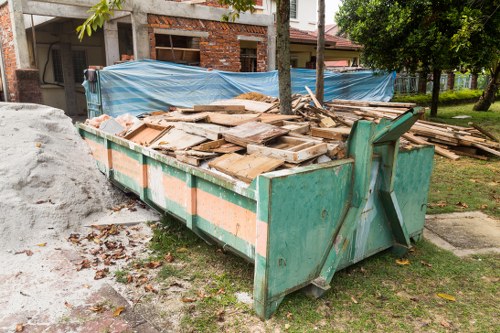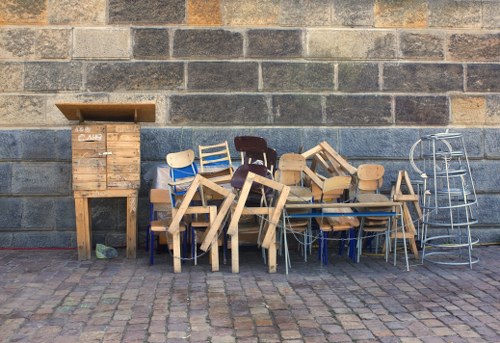Efficient Furniture Disposal through Council Largeitem Collection

Understanding Furniture Disposal
Disposing of old or unwanted furniture can be a daunting task, especially when considering the environmental impact and local regulations. Many councils offer largeitem collection services to help residents manage their unwanted large items efficiently and responsibly.
Furniture disposal is not only about getting rid of items but also about ensuring that they are recycled or disposed of in an eco-friendly manner. Utilizing council largeitem collection can make this process seamless and stress-free for homeowners.
Before scheduling a collection, it's essential to understand what items are eligible, how to prepare them for disposal, and the schedule for your local council's service.

Benefits of Council Largeitem Collection
Choosing council largeitem collection offers numerous advantages:
- Convenience: Schedule a pickup at your preferred time without the hassle of transporting items yourself.
- Environmental Responsibility: Councils often prioritize recycling and proper disposal, reducing landfill waste.
- Cost-Effective: Many councils offer this service for free or at a minimal cost compared to private disposal services.
By leveraging these benefits, residents can manage their furniture disposal needs effectively while contributing to a greener community.
Additionally, largeitem collection services can handle bulky and heavy items that are challenging to move, ensuring a safer disposal process.

Eligible Items for Disposal
Not all furniture items qualify for council largeitem collection. It's crucial to know which items are accepted to avoid any inconvenience:
- Large sofas and sectionals
- Dining tables and chairs
- Beds and mattresses
- Refrigerators and washing machines
- Office furniture like desks and chairs
Some councils may have restrictions on hazardous materials or require special handling for electronic appliances.
Before disposing of your furniture, check with your local council to confirm eligibility and any specific disposal guidelines.

Preparing Your Furniture for Collection
Proper preparation ensures a smooth collection process. Here are some steps to follow:
- Clean the items: Remove any debris or personal items from the furniture.
- Disassemble if possible: Breaking down large pieces can facilitate easier handling.
- Measure available space: Ensure that the items can be moved out of your property without issues.
- Label recyclable items: If you have items suitable for recycling, label them to assist the recycling process.
Taking these steps not only speeds up the collection but also enhances the efficiency of the council's disposal process.
Remember to place the items in the designated collection area on the scheduled day to ensure timely pickup.

Scheduling Your Largeitem Collection
Scheduling is a straightforward process:
- Visit your local council's website or contact their service center.
- Provide details about the items you wish to dispose of.
- Select a convenient date and time for the collection.
- Receive confirmation and any necessary instructions.
It's advisable to book your service in advance, especially during peak seasons, to secure your preferred time slot.
After scheduling, ensure all items are ready and accessible for the collection team to prevent any delays.
Council Regulations and Fees
Each council may have specific regulations and fee structures for largeitem collections:
- Frequency: Some councils limit the number of free collections per year.
- Fees: Additional items may incur extra charges.
- Scheduling Restrictions: Certain dates or times may be unavailable due to high demand.
Understanding these regulations helps avoid unexpected costs and ensures compliance with local laws.
It's essential to review your council's policies or contact their service department for detailed information.
Environmental Impact
Proper furniture disposal significantly impacts the environment. By utilizing council largeitem collection:
- Reduces landfill waste: Proper recycling and disposal minimize the burden on landfills.
- Promotes recycling: Many councils recycle usable furniture, giving items a second life.
- Conserves resources: Recycling materials reduces the need for new resources, conserving energy and raw materials.
Responsible disposal practices contribute to a sustainable future and support community environmental goals.
Moreover, recycling initiatives by councils can lead to the creation of new products, fostering a circular economy.
Tips for Efficient Disposal
To maximize the efficiency of your furniture disposal, consider the following tips:
- Plan Ahead: Assess and decide which items to dispose of before scheduling a collection.
- Sort Items: Separate items that can be recycled from those that need special handling.
- Communicate Clearly: Provide accurate information to the collection team about the items and their locations.
- Stay Informed: Keep up-to-date with your council's disposal guidelines and schedules.
Implementing these strategies ensures a hassle-free disposal process and enhances the effectiveness of council services.
Additionally, consider donating items in good condition to local charities, reducing waste and benefiting those in need.
Common Challenges and Solutions
While council largeitem collection is convenient, residents might encounter some challenges:
- Limited Collection Slots: High demand may lead to limited available times.
- Size Restrictions: Extremely large items might not qualify for standard collection.
- Special Disposal Needs: Items containing hazardous materials require special handling.
To overcome these challenges:
- Book collections well in advance to secure your preferred slot.
- Check size and weight restrictions before scheduling.
- Contact your council for guidance on disposing of special items.
Being proactive and informed can help navigate these obstacles effectively.
If necessary, explore alternative disposal methods such as private collection services or recycling centers.
Benefits of Timely Disposal
Timely furniture disposal offers several advantages for both individuals and the community:
- Space Management: Clearing out old furniture frees up space in your home or office.
- Health and Safety: Removing bulky items reduces the risk of accidents and improves living conditions.
- Aesthetic Improvement: A clutter-free environment enhances the overall appearance of your space.
Moreover, timely disposal prevents the accumulation of unnecessary items, promoting a minimalist and organized lifestyle.
It also ensures that furniture is handled before it deteriorates further, preserving any potential recyclability.
Community Impact
Effective furniture disposal positively affects the community by:
- Reducing Pollution: Proper disposal minimizes environmental pollution from decomposing furniture.
- Encouraging Recycling: Community-wide recycling efforts lead to significant material recovery.
- Supporting Local Initiatives: Councils often collaborate with local organizations to repurpose or donate furniture.
These collective efforts foster a sense of environmental stewardship and community responsibility.
Participating in council largeitem collection programs enhances community well-being and sustainability.
Alternatives to Council Collection
While council largeitem collection is beneficial, there are alternatives for furniture disposal:
- Private Disposal Services: Companies offer tailored disposal options, sometimes providing same-day service.
- Recycling Centers: Directly taking items to recycling facilities ensures responsible handling.
- Donation: Donating usable furniture to charities or non-profits aids those in need.
Each alternative has its own set of advantages, depending on individual needs and circumstances.
Evaluate the options to determine which method aligns best with your disposal goals and constraints.
Best Practices for Sustainable Disposal
Adopting sustainable practices in furniture disposal benefits the environment and community:
- Reuse: Before discarding, consider if the furniture can be repurposed or donated.
- Recycle Materials: Separate recyclable components to facilitate material recovery.
- Proper Handling: Handle items responsibly to prevent environmental contamination.
Implementing these practices ensures minimal environmental impact and promotes sustainability.
Encouraging others to follow sustainable disposal methods amplifies these benefits across the community.
Future of Furniture Disposal
The future of furniture disposal is moving towards more sustainable and efficient methods:
- Increased Recycling Efforts: Advances in recycling technology allow for better material recovery.
- Digital Scheduling: Enhanced online platforms make scheduling collections more user-friendly.
- Community Programs: Local initiatives focus on reducing waste and promoting circular economy practices.
These developments aim to streamline the disposal process, making it more accessible and environmentally friendly.
Embracing these changes can lead to a more sustainable and responsible approach to furniture disposal.
Conclusion
Furniture disposal through council largeitem collection offers a convenient, cost-effective, and environmentally responsible solution for managing unwanted furniture. By understanding the process, preparing items appropriately, and adhering to local regulations, residents can efficiently dispose of large items while contributing to community sustainability.
Don’t let old furniture clutter your space or harm the environment. Contact us today to schedule your council largeitem collection and take the first step towards a cleaner, greener living space.
